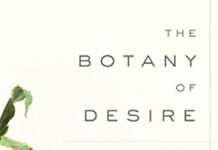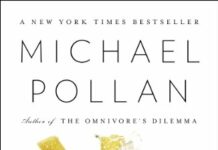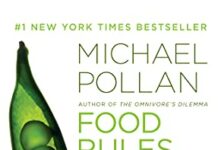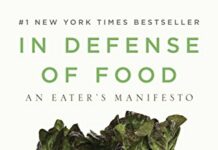
Ebook Info
- Published: 2007
- Number of pages: 450 pages
- Format: PDF
- File Size: 5.97 MB
- Authors: Michael Pollan
Description
“Outstanding . . . a wide-ranging invitation to think through the moral ramifications of our eating habits.” —The New YorkerOne of the New York Times Book Review’s Ten Best Books of the Year and Winner of the James Beard Award Author of This is Your Mind on Plants, How to Change Your Mind and the #1 New York Times Bestseller In Defense of Food and Food RulesWhat should we have for dinner? Ten years ago, Michael Pollan confronted us with this seemingly simple question and, with The Omnivore’s Dilemma, his brilliant and eye-opening exploration of our food choices, demonstrated that how we answer it today may determine not only our health but our survival as a species. In the years since, Pollan’s revolutionary examination has changed the way Americans think about food. Bringing wide attention to the little-known but vitally important dimensions of food and agriculture in America, Pollan launched a national conversation about what we eat and the profound consequences that even the simplest everyday food choices have on both ourselves and the natural world. Ten years later, The Omnivore’s Dilemma continues to transform the way Americans think about the politics, perils, and pleasures of eating.
User’s Reviews
Reviews from Amazon users which were colected at the time this book was published on the website:
⭐I almost never write reviews, but after the amount of time I devoted to reading this book and the gratefulness I have to Mr. Pollan for researching and sharing his knowledge and wisdom within it, I feel obligated.The book is well organized into Contents of 3 Parts: Industrial (Corn), Pastoral (Grass), and Personal (Forest). I have no idea why “Personal” was chosen over the term Hunter-Gatherer, as that was what he was going for. You may have picked up on that the Contents are in reverse chronological order, a timeline from current to pre-historic. In case you are wondering what “A Natural History of Four Meals” refers to, it is those three aforementioned Parts with Pastoral being subdivided into Big Organic/Industrial Organic and Small/Local organic. Pollan’s admirable and ambitious goal is to figure out how our food in the USA gets from earth to plate in each category.Part I – Industrial has a lot of eye-opening information in regards to farming, ranching, and the science. Even with all of that great information I found it the hardest part to get through as Pollan beats the metaphorical horse to death lambasting the industrial food system. I didn’t make it through Part I the first time I tried reading it 10 years ago and now I can see why. Even though it is the shortest of the 3 parts there is a redundancy and negativity where I felt it should have been edited down even further.Part II – Pastoral is the longest of the 3 parts and was my favorite part of the book. I grew up on a farm/ranch and some of the descriptions and emotions that he conveyed took me right back onto my family farm. I don’t think it would be much of a reach to assume Pollan a lefty/liberal city slicker having grown up in the New England, moved to California and teaching at Berkley, but in his writings of the “grass farmer” Joel you can tell how much respect and admiration he has for the man even though their personal and political beliefs may be worlds apart. I also thought Pollan’s critique and DILEMMAs he posed in this section led to some of his best writing in the book.Part III – Personal was a excellent conclusion to the book, though it does have a completely different tone to it. The first two Parts (Industrial and Pastoral) are an examination of the US food system. This last part is Pollan doing his best to recreate the hunter-gatherer food lifestyle while living in urban California, in hopes that it will add to the big picture he painted for us in the first two parts. As someone who grew up on a farm hunting it was refreshing to have a novice from the city, who likely looked down on us in someway, dive fully into the hunter outdoorsmen experience to understand our way of life. I’d be proud to buy Mr. Pollan a beer congratulating him on his first successful hunt. I also found the chapters on the mysterious mushrooms and preparing the food educational and entertaining. Angelo in particular seems like pretty cool, kickass dude.A few critiques:Mr. Pollan frequently uses personification when talking about plants and their evolution, like when he makes statements that corn chose us as much as we chose it. That’s not how it works and I found it to be a distracting and annoying repeated offense.Finished in late 2005, the book could use an update on the farming end. The farmers had a nice run for a stretch, lets say 2009-2015. Things have turned really ugly in both the cattle markets and commodity markets since then. It would be nice to see an update of why things turned around for the better, then flipped again. And we could always use a few more wise words from Mr. Joel Salatin.Looking forward to reading and reviewing “In Defense of Food”.
⭐How can people in France or Italy are able to eat all the “unhealthy” meals filled with pasta, bread, and the likes of foie grass but can wind up healthier, thinner, and happier compared to those who consume supposedly healthy diet of low-carb, high protein, and good fat?This book is the long history of our meal since the dawn of civilisation. The author, journalist Michael Pollan, went back to the very beginning of the food chain to track the process of food manufacturing, from the nature to the plate. And the result is this best-selling book that has since become one of the main go-to guides for healthy eating for more than a decade.So, what did Pollan discover? The Omnivore’s Dilemma is about the three core food chains that sustain us today: 1. The organic 2. The hunter-gatherer 3. The industrial. While they differ greatly, all three food chains are systems with similar functions that are linking us to the fertility of the earth and the energy of the sun, through what we eat. Even the Twinkies. As Pollan remarks, “all life on earth can be viewed as a competition among species for the solar energy captured by green plants and stored in the form of complex carbon molecules.”And a food chain is a system for passing on those calories to species that lack the plant’s ability to synthesize them from sunlight. And this lies the problem with the industrial food chain, as the supposedly natural carbon molecules are being greatly modified for profitability.As Pollan explains, each of us can only eat approximately 1500 pounds of food a year. And unlike many other products – such as shoes or CDs – there is a natural limit to how much food that we can consume until we reach our ultimate limit. This is a bad news for the food industry and its Wall Street investors, with the food industry’s natural rate of growth is only around 1% per year (in the US).This left corporations like McDonald’s and General Mills with 2 options if they hope to grow faster: 1. Figure out how to get people to spend more money on the same amount of food, or cutting the cost of production for the same amount of food 2. Figure out a way to make people eat beyond their natural limitations. And the food industry pursue these 2 strategies simultaenously and complementarily, mainly by using cheap (but unhealthy) corn for cost cutting.Indeed, there are around 45,000 items in the average American supermarket, and more than a quarter of them now contain corn. One of the most common examples for cost cutting is replacing sugar with High Fructose Corn Syrup (HFCSH), because HFCS is few cents cheaper than sugar (thanks to government subsidy) and the change went unoticed by the consumers, such as the one conducted by Coca-Cola and Pepsi in 1984. Besides in soda drinks, HFCS can also be found in bread, candy, canned fruit, sweetened yoghurt, juice, and many more, including in salad dressings.As Pollan remarks, “very simply, we subsidize high-fructose corn syrup in this country, but not carrots. While the surgeon general is raising alarms over the epidemic of obesity, the president is signing farm bills designed to keep the river of cheap corn flowing, guaranteeing that the cheapest calories in the supermarket will continue to be the unhealthiest.”And with all the nutritions aren’t met with these “junk” food, in search for the required amount of nutritions our body then demands us to eat more and more food and snacks, which normally also still lack the nutritions needed, thus leads to the epidemic of obesity (but fulfilling the corporations’ 2nd goal to make people eat beyond their natural limitations).Moreover, in the quest of cutting down the cost of production, the meat industry also opted to use these subsidied corn to replace grass as the main source of feeding for cows, with an added advantage of speeding up the fattening process for the cows since corn is a compact source of caloric energy.As Rich Blair – a person who runs a “cow-calf” operation (the first stage in the production of a hamburger) – commented “in my grandfather’s time, cows were four or five years old at slaughter. In the fifties, when my father was ranching, it was two or three years old. Now we get there at fourteen to sixteen months.” And Pollan added, “cows raised on grass simply take longer to reach slaughter weight than cows raised on a richer diet, and for half a century now the industry has devoted itself to shortening a beef animal’s allotted span on earth.”As a result of these changes corn-fed cows get fatter in a much quicker time. And their flesh also marbles well, giving it a texture and taste that American consumers have come to like. In the industry terms, it seems that the factory is becoming more efficient in increasing production at a lower cost.However, according to Pollan, “this corn-fed meat is demonstrably less healthy for us, since it contains more saturated fat and less omega-3 fatty acids than the meat of animals fed grass. A growing body of research suggests that many of the health problems associated with eating beef are really problems with corn-fed beef.”So, how to counter the health problems? They inject the cows with antibiotics. As Pollan discovered, “what keeps a feedlot animal healthy—or healthy enough—are antibiotics. Rumensin buffers acidity in the rumen, helping to prevent bloat and acidosis, and Tylosin, a form of erythromycin, lowers the incidence of liver infection. Most of the antibiotics sold in America today end up in animal feed, a practice that, it is now generally acknowledged (except in agriculture), is leading directly to the evolution of new antibiotic-resistant superbugs.”This partly explains why French and Italian people are healthier despite their [perceivedly bad] diet. Because they eat more high quality organic food, they do less snacking because they eat more good fat and in overall they meet the required nutritions. In addition, they also use less chemically altered vegetables oil (that will trigger insulin resistance), they use non gmo food, no artificial vitamins, and all other changes as a result of industrialisation of the food chain.Or in other words, the French and Italians simply eat real food while in America people eat a manufactured, chemical-filled, substance that they label as food.The remaining of the book then tells the story of Pollan’s journey to several places in America to experience first-hand how organic food chain (aka real farming) and hunter-gathering food chain should look like. And the result of this reporting is a massive game changer. Since the book was published in 2006, the reactions within the food industry have been overall positive.In Pollan’s own words, “there are now more than eight thousand farmers markets in America, an increase of 180 percent since 2006. More than four thousand school districts now have farm-to-school programs, a 430 percent increase since 2006, and the percentage of elementary school with gardens has doubled, to 26 percent. During that period sales of soda have plummeted, falling 14 percent between 2004 and 2014. The food industry is rushing to reformulate hundreds of products to remove high fructose corn syrup and other processed-food ingredients that consumers have made clear they will no longer tolerate.”Moreover, Pollan continues, “sales of organic food have more than doubled since 2006, from $16.7 billion in 2006 to more than $40 billion today. The kind of grass-finished beef and pastured eggs that Joel Salatin produces at Polyface Farm were so exotic in 2006 that national sales figures for them didn’t exist; now, you can find these foods in many supermarkets, and both categories are growing by double digit percentages each year. (Carl’s Junior, the fast food chain, introduced a grass-fed hamburger in 2014.) From California to Georgia, there are now hundreds of farms modeled on Polyface’s intricate choreography of animals. And Joel Salatin himself has become an international celebrity farmer, a social type I don’t think existed in 2006.”Hence, when today you see an evolution towards organic eating, ethical farming, and an overall healthy living, you can trace back the evolution to this book as one of the main instigators. A must read for those who care about where our food is coming from.
⭐In my opinion, this book should have been cut in half the size in editing. There is a lot of unnecessary information in the book, lots of little stories which, frankly, did not interest me so I skipper most of them. I buy this type of books to find out information, not to read little stories. For that, I buy novels. The style is monotonous. I tried a few times to finish the book but I couldn’t so I just gave up at page 200. What I really didn’t like about this book is the fact that the author allocated 50 pages to talk about organic food as apposed to 100 pages to talk about corn and 100 pages to talk about grass. The conclusion was that organic food is bad for the environment due to processing and transportation. That made me think that is a hidden agenda in this book and I still don’t understand why would anybody discourage you from eating healthy food. I like to eat healthy and I cannot grow my own food. So what are my options? I was hoping to find the answer in the book. I didn’t.
⭐Review courtesy of subtleillumination.comWhy do you eat what you do? How was it produced? If you can answer with more than the aisle of the supermarket you bought it from, well done. If you can’t, does that worry you? Is all food created equal and of equal health benefit? Is beef from a grass-lot the same as feed-lot, or vegetables grown industrially the same as organic? Do you know the answer to that? If not, does that worry you?Michael Pollan argues it should worry us. Three principle chains of food sustain us, all of them linking one biological system, ourselves, with another, a patch of soil. Most of us, however, remain woefully ignorant of any sort of understanding of our food systems. In The Omnivore’s Dilemma, Pollan explores each of the three methods of food creation, industrial, organic, and hunter/gatherer, and examines the costs and benefits of each.There are of course two sides to every story, and Pollan is careful to examine the benefits from cheaper food in terms of health and living standards. He’s right, and the animal rights movement sometimes unfairly ignores these benefits. The reality though is that most of us aren’t in a position to decide either way; we remain willfully blind to the reality, ignorant of what we eat and where it comes from. Perhaps the tradeoff is worth it, but we should at least be aware of the processes our food goes through, whether that means glass walls on slaughterhouses or increased education about industrial production. In the end, what you eat is a personal choice, but it’s one that should be made out of information, not ignorance.
⭐I found this book by accident – it was recommended in the appendix of another book I was reading about (of all things) beer. I spend a lot of time reading about, preparing, and eating food and I liked the idea of finding out more about how our modern food chain functions. This book was definitely thought-provoking and enlightening, though it’s not written in a way that will necessarily lead you to a particular outcome – it didn’t feel to me like the author was driving a vegetarian/vegan/revolutionary/radical agenda. Rather, it’s more a tale of an individual journey towards a greater understanding of where our food comes from – which really resonates with me. It is definitely written with a clear North American focus, but in our modern globalised economy I think many of the same truths are applicable here in the UK (and around the world). It’s really spurred me to take a closer look at what I eat (including many of the finer details of the ingredients list of processed foods), where it comes from, and how it was produced. I’m not sure yet what that means for me personally, or what actions I’ll take on the back of having all this new information. But knowledge is always good and I hope it will help me be a more responsible, ethical, and conscientious consumer.
⭐If what goes on in the US eventually comes here, we had brace ourselves. It made me really think again about where our food comes from and what we are eating that is making us sick and fat. Good food should be cheap, but this really reveals the extent to which in our times, rubbish food is cheap and is often all people can afford. A sobering, but still entertaining read. I like the author’s style of writing very much.Quirky and humorous, but informative too. Anyway, I was off to the farm shop after reading it and resolved to avoid processed food even more than before.If chicken is so cheap, how is it being reared? ditto all cheap meats, farmed fish, pesticide laden out of season fruit and veg. I wonder if history will reveal that one of the prime culprits for public health decline is the indiscriminate use of vegetable oils, particularly corn oils and its derivative,high fructose corn syrup. You won’t want it if you read this book.
⭐I had a feeling I would like this book and I was right. It offers an insight into the whole of the food industry in the US. Although I am from the UK many practices in the US are going on over here. I didn’t find it too bias, I thought maybe the author was slightly judgmental of industrial food, however after experiencing what goes on there I can see why he would be, even if he was trying not to be. I think its a great book if you care about what you eat, where it comes from and how it was grown/raised. Its not a book which will help us feed the world, but it will help individuals eat better. I doubt we will ever be rid of industrial farming, in fact I see the opposite happening no more organic or sustainable grown food instead multinational companies in control of GM food. But that’s only because of the power they wield. Hopefully though that will be after my lifetime.If you want to open your eyes to the food industry and learn something, then I suggest you read this book, if not, then trot off to McDonald’s.
Keywords
Free Download The Omnivore’s Dilemma: A Natural History of Four Meals in PDF format
The Omnivore’s Dilemma: A Natural History of Four Meals PDF Free Download
Download The Omnivore’s Dilemma: A Natural History of Four Meals 2007 PDF Free
The Omnivore’s Dilemma: A Natural History of Four Meals 2007 PDF Free Download
Download The Omnivore’s Dilemma: A Natural History of Four Meals PDF
Free Download Ebook The Omnivore’s Dilemma: A Natural History of Four Meals





